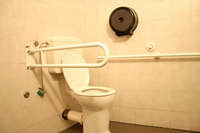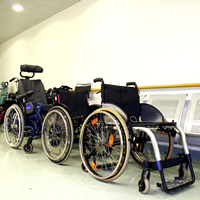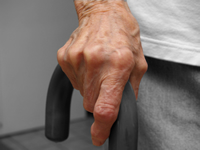Assistive Devices

After stroke, a person may have trouble walking, talking or moving around. Tasks such as dressing oneself may be difficult. Assistive devices can help.
What Are Assistive Devices? 
Assistive devices can help a person function better and be more independent. Assistive devices can make daily tasks easier. These devices may help ease the burden on you as a caregiver.
What Do You Need to Know?
There are many different assistive devices to choose from. They can range from simple to complex. Focus on your loved one’s needs to guide you. Schedule an appointment with a physical or occupational therapist to assess your loved one. Ask questions about what devices would be best. Be sure to include your loved one in the decisions.
What Are the Different Types of Independent Living Aids?
Many devices are available to help with activities of daily living (ADLs). ADLs are the normal everyday tasks that people do. These include cooking, eating and house cleaning. ADLs also include personal care tasks like bathing and using the bathroom. Examples of helpful devices are listed below.
Kitchen aids help with cooking and feeding oneself:
- Rocker knives for one-handed cutting
- Easy to grip silverware
- Jar openers
- Reaching tools
Bedroom aids make moving around at night safer:
- Bedside commodes
- Transfer boards
- Night lights
Bathroom aids help with bathing and toileting:
- Hand-held shower head
- Transfer bench for tub
- Shower chair
- Grab bars by toilet
Dressing aids make dressing oneself easier:
- Zipper pulls and Velcro®** tabs
- Elastic or non-tie shoelaces
- Easy-to-pull sock and panty hose aids
Grooming aids help with personal hygiene needs:
- Long-handled combs and brushes
- Electric toothbrushes
- No-rinse shampoo and body wash
What Are the Different Types of Mobility Aids?
Mobility aids help with walking or moving from place to place. They can help prevent falls and improve independence.
Gait belts and lift vests:
- Make lifts and transfers safer
- Provide secure handhold for caregivers when walking is unstable
- Help caregiver balance survivor
Canes:
- Decrease stress on the weak or affected leg
- Simple but effective walking tools
- Widen the base of support
- Various types of canes are available
Crutches:
- Provide support under the arm to take stress off the leg
- More stable than canes
- Various types of crutches are available
Walkers:
- Offer additional support to make up for lost strength
- Provide maximum stability
- Should be sized to fit user
- Various types of walkers are available
What Are the Different Types of Wheelchairs?
Wheelchairs are designed to help those who can no longer walk safely. They come in many shapes, sizes and varieties.
Manual wheelchairs:
- Depend on physical strength of the user or attendant
- Require arm or leg strength to move – unless there is someone to push
- Lightweight; easy to push and maneuver (dependent on weight of user)
- Less costly than motorized wheelchairs
Motorized or electric wheelchairs:
- Powered by battery or electricity
- Less physical exertion is required
- No one needs to assist user
- Your loved one must be able to make decisions and maneuver safely
Scooters:
- Work well for people who can get in and out of a chair
- Often less expensive than powered wheelchairs
- Easier to maneuver than a standard wheelchair
What Kinds of Financial Help Are Available?
No one insurance or public program covers all the costs of assistive devices. Some coverage will depend on the state you live in. Some assistive devices can be replaced free of charge every 3-5 years. Check with your social worker. See below for where you can find help paying for devices. The Resources section has contact information for some of the resources below.
Department of Veterans Affairs − The VA provides assistive devices to Veterans who receive VA care. This is based on disability and service connection. Check with your local VA to determine what your loved one qualifies for. Start with your loved one’s primary physician. The primary physician must approve the request for assistive devices. Once approved, a request will be placed in the computer. The device will then be provided through prosthetics, occupational or physical therapy. This will depend on the type of equipment.
VA Health Benefits Service Center − This center provides information on VA benefits for assistive technology.
Medicare − Benefits may include assistive devices, such as wheelchairs and scooters. Certain medical criteria must be met.
Medicaid − A program providing health coverage for lower income and disabled people. Benefits will vary by state.
Private Insurance − Insurance policies vary. Most policies cover at least some of the cost of assistive devices. Check with your insurance company to find out what is covered.
Associations and Foundations − Some associations and foundations will help pay for assistive devices, such as Disabled American Veterans.
Where Can You Buy Assistive Devices?
Check your phone book for medical equipment and supply stores. Ask your physical or occupational therapist. There are also on-line healthcare product stores. Look in the Resources section for contact information.
Helpful Tips to Decide Which Assistive Devices to Use
- Think about what tasks your loved one needs and wants to do. Look for devices that would help with these tasks.
- Pick the simplest device to meet your loved one’s needs. Complex devices are often harder to use.
- Ask your healthcare team for advice. An occupational therapist (OT) or physical therapist (PT) can guide your decisions.
Remember
- Assistive devices can help your stroke survivor be more independent.
- Check with your local VA to see what assistive devices are available.
- Have your loved one evaluated by a physical or occupational therapist.
Other Resources 
Additional credible resources on this topic can be found here. Website pages may change or update, therefore if a link does not work, you may also try to type the information into your internet search bar. This Resource List will be updated frequently.
|
*Link Disclaimer: Links to information and Web sites outside of the Department of Veterans Affairs do not indicate an endorsement of products or services offered by the sites. In addition, these sites may have privacy and security policies that are inconsistent with those of VA. |
References: Family Caregiver Alliance. (2005). Fact Sheet: Assistive Technology. Retrieved March 4, 2009, from: http://www.caregiver.org/caregiver/jsp/content_node.jsp?nodeid=1412*; Emedicine. (2009). Assistive Devices to Improve Independence. Retrieved March 2, 2009, from: http://emedicine.medscape.com*; Administration on Aging. (2009). Assistive Technology. Retrieved April 15, 2009, from: http://www.aoa.gov (This resource is no longer available.) now Administration for Community Living. (2024). Assistive Technology. Retrieved February 22, 2024, from: https://acl.gov/programs/assistive-technology/assistive-technology; About.com. (2009). Assistive Devices for Disabled- Who Pays? Retrieved April 15, 2009, from: http://seniorhealth.about.com/library/weekly/aa093000a.htm*; Medline Plus. (2009). Mobility Aids. Retrieved May, 12, 2009, from: http://www.nlm.nih.gov/medlineplus/*; Eldercare Locator. (n.d.). Assistive Technology. Retrieved May 12, 2009, from: http://www.eldercare.gov/*
These materials were created for the project:
Web-Based Informational Materials for Caregivers of Veterans Post-Stroke
Project Number SDP 06-327 funded by VA HSR&D Quality Enhancement Research Initiative (QUERI)



















